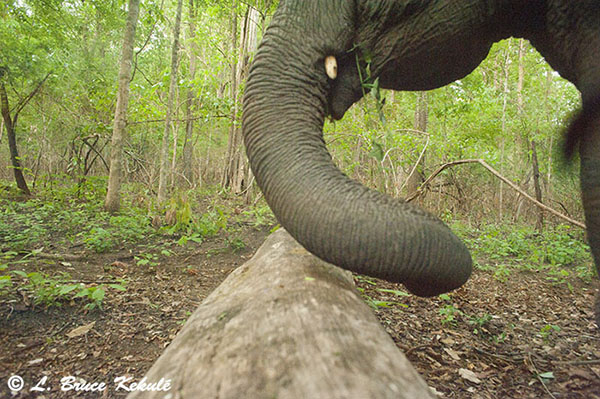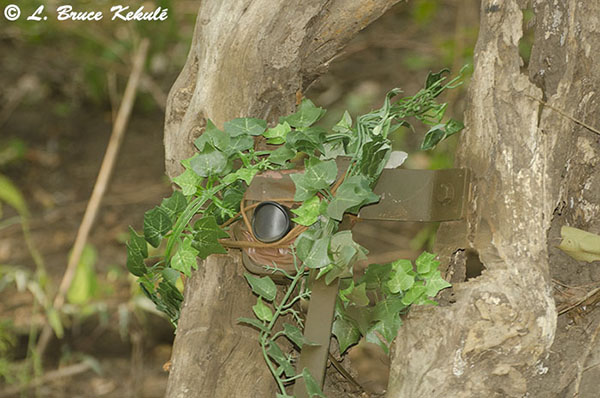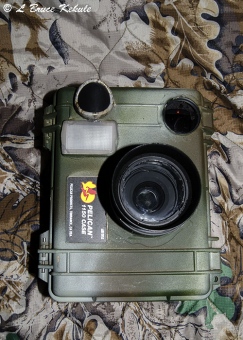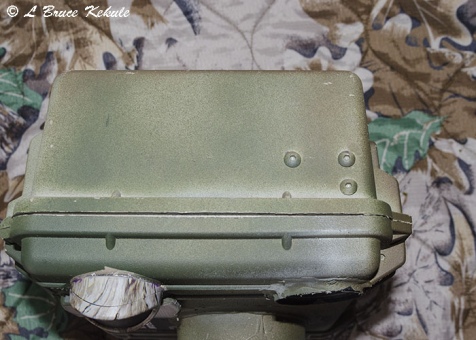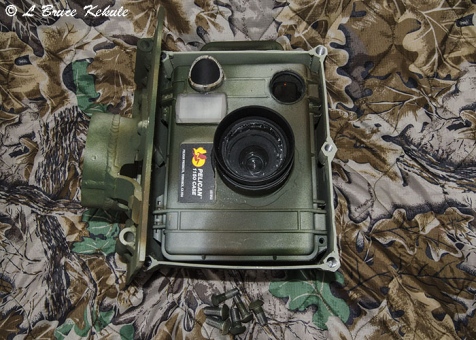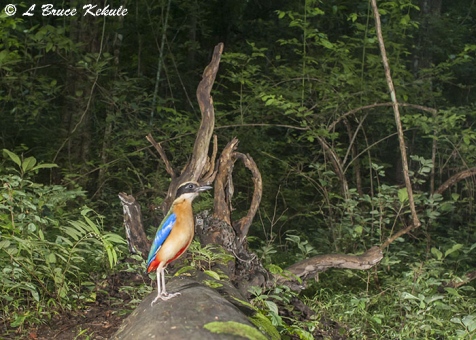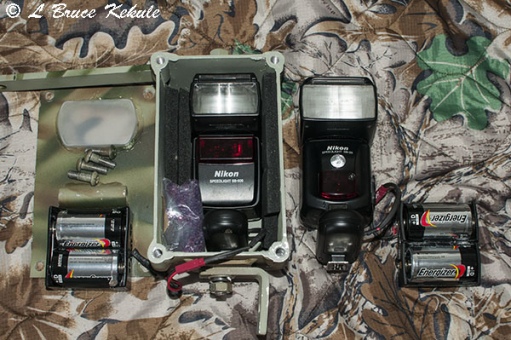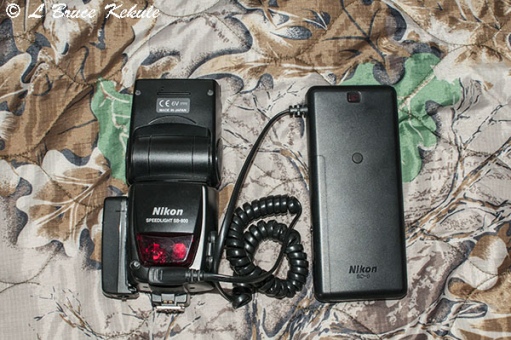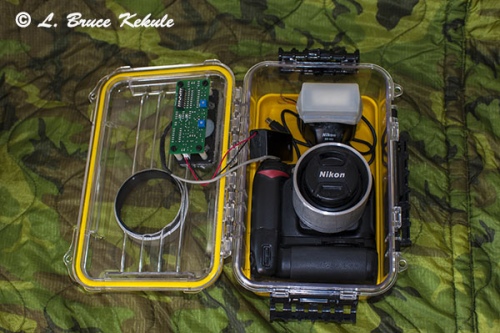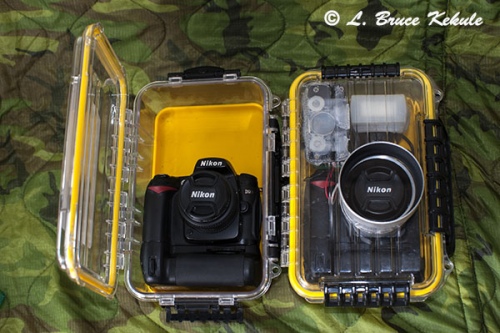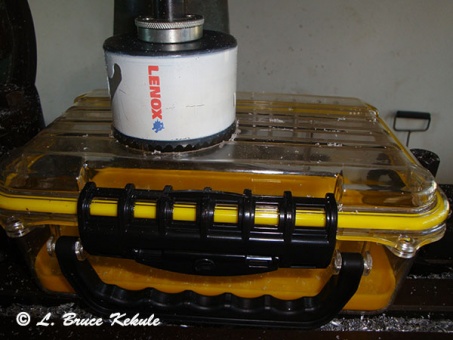Posts Tagged ‘Nikon DSLR camera trap’
Nikon D700 catches a male leopard on one paw…!
A big cat crossing the ‘tiger log’
Male leopard shot #1.
Male leopard on one paw….shot #2.
Male elephant – the flash destroyer.
Elephant back for more.
Banteng bull.
Evert year, forest fires occur in Thailand’s ‘Western Forest Complex’ during the dry season usually started by the human population living around the protected areas. Occasionally, lightning ignites fires but this natural phenomena, is less frequent. Stray cigarette butts also account for many fires. For the most part, local poachers start them to allow long distance spotlighting during the night. With the brush gone, they are able to see the reflection in the eyes distinctly (usually deer) with their headlamps.
Occasionally these fires are fierce and any camera trap left in the forest during this time will likely be destroyed. I always move my cams to evergreen forests from about February through to April that normally do not have fire, and this year was no different. But as soon as the first monsoon rains come in mid-April, the forest is safe once again for camera trapping.
With the first good rains through, I decided to setup my Nikon D700 back on the log. This time the cam is using a hardwired SSII sensor (Snapshotsniper.com) with a 10-meter cable setup in the tree stump apposite the cam. Also, a third flash was added and installed above the cam’s ‘elephant proof ‘ box. However, the ‘third flash’ is now history as a young tusker found it and turned it into rubble (below) but the cam, the sensor and two other flashes survived.
It was great to see this male leopard cross over the log. The first image is a good record shot but the second one is really something special catching this mature predator on one paw with the other three in mid-air. Also, the reproductive organ is sharp and just hanging there with its tail is balancing the big cat. He looks like he is winking at the cam. Once again, within two shots, the leopard turned his head to see what the flash was all about just like my tiger in late January 2014. The speed and reaction time of these felines is legendary and it doesn’t get any better…!
I also got the elephant that destroyed the third flash plus a banteng bull that stopped short but did not cross over. All in all, it was a great start to a new season at the ‘tiger log’. The full-frame D700 firing off a two-shot burst is in its element with a 28mm lens but now with only two flashes thanks to the forest giant. I have installed a 35mm lens this time to see what a tighter crop will do. Enjoy..!
Damaged SB-28 flash.
Nikon D700 setup on the log.
Hardwired external SSII (Snapshotsniper.com) sensor.
Hardwired Nikon SB-28 flash setup.
*****************************************
D700 settings: ƒ8 – 1/125 at ISO 400.
Edited in Adobe Camera Raw.
Leopard shot #1: full-frame.
Leopard shot #2: cropped.
Elephant and banteng bull: full-frame.
A Jumping Tiger: Nikon D300s DSLR catches a big cat
The speed and reaction time of an Indochinese tiger is measured in milliseconds….!
The video is a bit raunchy and music is strong but I wanted something else for a change…! This is the most amazing behavior of a tiger I have ever seen.
I set my Nikon D300s DSLR trail cam deep in the forest at a mineral spring where all of Thailand’s large wild mammals like elephant, gaur, banteng, tapir and sambar plus others come for ‘life-giving’ minerals and a drink, and where tigers coming looking for prey.
This cam (set to manual 1/125 – ƒ8 – ISO 400) with a 35mm lens with a Snapshot Sniper SSII sensor fires-off salvos of 8 frames a second every time it records motion. The Nikon D300s was perfect for this location
I was hoping to catch a tiger and thought I might get lucky…but after going through the files, I found 13 photos of a tiger jumping away from the cam. This action footage is my best so far of the tiger in Thailand. The cat is not exceptionally sharp but movement never is and it does not have to be…..!
Amazingly, this male tiger heard the first shutter and reacted in less than three frames and started moving away in what I would like to say, blinding speed…! He looks to be mature judging from his scrotum. This place is truly the last great tiger haven in Thailand and worthy of it’s ‘World Heritage Site’ status…!
All I can say, it’s going to be tough to top this sequence….!
Enjoy…!
Nikon D300s trail cam: A multi-purpose DSLR
A camera trap with two sensors and two flash systems
A Nikon D300s trail cam in a Pelican 1150.
My latest cam is probably the most versatile DSLR trail cam I have built so far specifically put together for the varied conditions and camera trap setups found in Thai forests. With fantastic opportunities for the big cats, wild cattle and other amazing creatures, I decided to build this unit for several reasons.
My choice of a Nikon D300s was three-fold: I found one in used condition at a fair price. I already had a Nikon ML-3 ‘Modulite Remote Control’ trigger that works with the Nikon D200 up to the D800 plus the pro-size Nikon bodies with the 10-pin plug. The D300s is a medium sized camera that just fits in a Pelican 1150 case that I also had. I prefer this size for most of my DSLR trail cams.
The Pelican 1150 opened showing internal components.
Another motive for the D300s was its ability to produce very little noise at high ISO settings. The cam has a Nikon ‘DX’ fixed 35mm ƒ1.8 lens and uses a MB-D10 battery grip with two EN-EL3e batteries. I will be starting out with ISO 400 and if I get too many dark daytime images, will go up a notch or two and probably stay at 800.
This unit has two sensors: the active infrared ML-3 and a passive infrared Snapshot Sniper SSII board that can be easily switched from one to the other. A special aluminum holder was made-up for the ML-3 receiver attached to the case with three 8/32” button head machine screws at the top on the right. The SSII was placed on the left over the flash.
The top end showing three screws holding the ML-3 receiver.
The ML-3 transmitter is housed in an ‘elephant proof’ aluminum box and has 10mm pivot bolts and L-plates. A laser pointer fits in the tube at the top to help in alignment and the box is adjustable for all angles. A 10mm ‘Python’ locking cable 10mm runs through a pipe welded to the faceplate.
ML-3 transmitter with the ‘laser pointer’ in an ‘elephant proof’ aluminum box.
There are two flash systems: a Nikon SB-400 with two AA externals and SC-17 sync cable (shortened) to fit upside-down next to the cam on the left, and to fire off on every shot tripping a Nikon SB-80 with two 4-pack AA externals (either new Eneloop or AA Lithium) with the flash set to remote. An ‘elephant proof’ box houses the SB-80 and battery packs with stainless steel 10mm pivot bolts, nuts, lock washers and L-plates and is adjustable for most angles. Another ‘Python’ cable secures the flash.
Slave flashes to be used with the D300s; Nikon SB-80 (right)
and National’ generic slave flash (left).
The other system is a PT-04NE FM Radio Speedlite trigger (transmitter and a couple receivers) mounted to an SB-80 and a SB-28 as slaves. I will explain my reason below for the ‘two in one’ system on both the sensors and flash. Another slave flash was built using a ‘National’ generic flash with two 2-pack AA externals for a total of eight AA batteries. A ‘Nissin’ flash trigger I had for more than a decade and recently found along with a ‘National’ sync cable to control the flash, works very well. This all fits nicely in a clear Pelican 1030 and I built my ‘elephant proof’ box as shown that is also adjustable.
Unfortunately, the Nikon ‘wireless flash system’ using the pop-up flash is not viable because the cam will only fire once (even in continuous mode) and then wait a second or two before tripping again. I need multiple shots in continuous mode (5-6 shots) to catch quick stepping animals more than once. The Nikon SB-600, 700, 800 or 900 can be tripped with the pop-up flash (line-of-sight) but it’s just too slow for this cam.
The reason I’m using a SB-400 is simple; it will fire on the first trigger and follow-up shots specially with AA Lithium batteries. It also has loads of power (better than the flip-up) to fill the frame and is TTL. A few remote slaves strategically placed will reduce ‘eye-shine’. I have made up a simple mirror system to direct light straight into the flash sensor as an experiment.
Experimental mirror to be angled directing light into the flash sensor
and attached to the tree above the flash unit.
The camera was a tight fit actually expanding the case a bit but after some serious sanding with a drum sander on both the case and cam, it now slips down nicely to the bottom and it closes easily. The sides of the case are slightly thinner but will not be a problem. However, a notch had to be cut for the shutter cable but that’s all.
The snorkel is thin aluminum tubing with a 77mm UV filter. The flash hole is covered with a shortened Nikon diffuser and the ‘ML-3 receiver’ is covered by a 40.5mm UV filter on the right, and the SSII and HPWA are fitted on the left. Marine ‘Goop’ is used on all ports.
D300s trail cam in an ‘elephant proof’ aluminum box.
As usual, an elephant proof box was made up for the cam to just fit and is installed on a tree using four 3” x 3/8” stainless lag bolts from inside the box. Four 12mm socket and two 10mm ‘power torque’ machines screws attach the faceplate and two 10mm (3/8”) ‘Python locking cables’ slip through pipes welded to the front for extra security. Camouflage paint in my usual ‘no two alike’ pattern. I will also be using dried moss glued on to the faceplate and sides of the box. Plastic leaves are wrapped around the box and locking cables to conceal everything.
The reason for the ‘two in one’ system: When there is heavy insect activity during the rainy season (now), large beetles, butterflies and moths will trip an active infrared sensor shooting an empty forest. I would use the passive infrared during this time. But during the dry season and for exact tripping, the ML-3 active infrared is more precise.
On the flash: some setups that can use light sensitive slave flashes, the SB-400 would be activated. Others sites that would require radio transmitted flash control due to tree or root placement, the radio trigger would be used. I can be selective on both systems and everything stays in the 1150.
I really look forward to setting this cam and will post the first set-up when done. Hope this helps those with ‘DSLR’ madness (like me). Just kidding…! Enjoy.
Nikon D700 trail cam set
Creatures on the log: A giant rodent, a pitta and an eagle
Not much passed over the dead tree last month but I did get a few interesting creatures that stopped by. The Nikon D700/35mm lens/ML-3/Pelican 1150 with three Nikon SB-28s worked very well. An Asiatic porcupine crossed over, and a blue-winged pitta and then a changeable hawk-eagle with prey landed on the log. Due to the 35mm lens, it seems a bit wide with the full-frame sensor and had to crop these images. I will be putting a 50mm when I get back to the unit next month…in the meantime, the cam is working very well and looking forward to those big cats with stripes and spots….!
Porcupine
Blue-winged pitta
Changeable hawk-eagle with prey (feathers already plucked)
Changeable hawk-eagle’s departure
Nikon SB-600/SB-800-900/SB-28 DSLR slave flash
Nikon remote flashes
Nikon SB-600 (middle), SB-800 (left) and SB-28 (right) remote flashes.
After installing and testing my D700 trail cam with several remote SB-28 flashes in the forest, it was apparent I needed another flash closer to the cam on the right side of the fallen tree to eliminate the shadow.
I had an old SB-600 that has been one of my mainstay flashes for some time and since I don’t shoot much flash now, thought I would regulate this one to camera trap duty.
SB-600 and SB-28 with Yongnuo Wireless flash triggers and ‘D’ cell externals.
I will be setting this flash with four brand-new ‘Enelope’ rechargeable batteries to see how long they will last on standby.
A Yongnue 602n wireless flash trigger and two ‘D’ cell externals is used and the assembly is housed in one of my ‘elephant proof’ aluminum boxes. I have now tested the ‘D’ cells and getting more than a month on stand-by…!
‘D’ cells in place.
On this box, I beefed-up the ends and drilled and tapped for 10mm machine screws and set with epoxy to act as pivots, and a ‘L’ bracket on the bottom and a 1” x ¼” x 14” aluminum strap across the top of the log. I can aim the flash straight at the trail and lock it in place. A generic flash diffuser is shortened to about 1/4″ and then ‘Goop’ is applied after camouflage painting.
By using two or three 3” x 3/8” stainless lag bolts, the flash will be tight, and elephants or bears would have hard time breaking these flashes. However, a bear-tooth through the diffuser could be a problem. Of course the proof is in the pudding and we shall see because the big elephant herd will come through one day, and they will surely have a go at destroying the whole set…!
SB-800 with an extra AA battery pack (5 AA cells).
In this box, I can also use a Nikon SB-28 flash that has a great stand-by feature, and is fairly cheap and readily available on the second hand camera market. A SB-800/900 can also be used.
I’m also working on a couple of SB-800s that will have extra Nikon battery packs (5-AAs) set to remote plus the 6-pack. During testing, they work extremely well but are still not TTL. Still working on that. Hope this helps those who need some tough slave flashes for your DSLR trail cam.
SB-800 with Nikon 6-AA battery pack.
LBK ‘Clear-view’ Nikon DSLR camera trap
Nikon N90s/Nikon SB400/Plano 1460/ Yeticam sensor board
A new DSLR homebrew camera trap in the make-up phase
When I began shooting wildlife with a camera some 16 years ago, I chose Nikon because of several reasons but rugged camera bodies and great lenses were the main factor. I’ve always been partial to this brand. However, after horrible Nikon service here in Thailand run by a local tyrant, I switched to the Minolta brand in film and then Konica-Minolta in digital. After they went belly-up, I went back to Nikon and fortunately the mother company from Japan is now running things here in Thailand including excellent service.
I picked up two D90s that is reasonable in price and very good for quality images. A couple of generic battery packs were purchased and use two Nikon EN-EL3e lithium batteries in each. I had some old ‘Yeti’ boards and ordered two “EOS” chips from Mark over at Yeticam.com. This is my first homebrew DSLR using a Nikon and I chose a 50mm lens for this rig. With a 1.5-factor, the lens is comparable to a 75mm that is OK for frame filling shots that I prefer for camera trap images.
Both units ready to be completed
While in the States recently, I found some Plano ‘Guide Series’ # 1460 cases at Dick’s Sporting Goods up in New York that looked perfect for a DSLR cam. I bought two in clear as my plan for this cam was to use a small Nikon SB-400 flash shooting straight through the case and activating some remote slaves. A flash diffuser will be used to soften the flash. By using the flash on the hot shoe, precise TTL metering can be had and the slaves are used for fill lighting.
The snorkel is made from aluminum tubing and these will be anodized and then ‘Gooped’ in. A 77mm circular UV filter with a hood is attached. Due to limited space the Yeti board is installed in the vertical position to allow for precise triggering.
Machining case for the lens snorkel
As soon as possible, ‘elephant proof ’ aluminum boxes will be built to house these two cams. Due to the size of the box, I will be incorporating angled plates on the top and sides to keep elephants from getting a grip. Four 3/8” x 3” stainless steel lag bolts will be installed from inside the box and 4 to 6 10mm ‘power torque’ machine screws will close the faceplate. A heavy-duty 10mm (3/8”) Python locking cable will also be used.
When these are finished, I will post photos of the complete builds. In the meantime, remote slaves will be acquired and aluminum boxes will be built for them too. The main reason for this build is improved image quality. Hope this helps any budding DSLR homebrew builders…!





